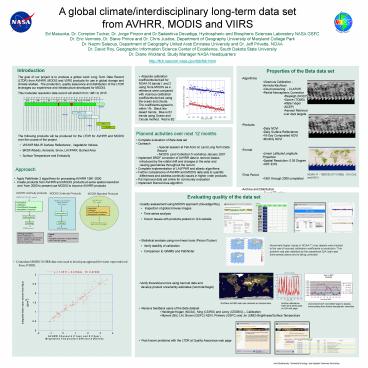A global climate/interdisciplinary long-term data set - PowerPoint PPT Presentation
1 / 1
Title:
A global climate/interdisciplinary long-term data set
Description:
Dr. Diane Wickland, Study Manager NASA Headquarters. http: ... (time series) above and is being corrected. 50x50km AVHRR data cuts centered on Aeronet sites ... – PowerPoint PPT presentation
Number of Views:22
Avg rating:3.0/5.0
Title: A global climate/interdisciplinary long-term data set
1
A global climate/interdisciplinary long-term data
set from AVHRR, MODIS and VIIRS
Ed Masuoka, Dr. Compton Tucker, Dr. Jorge Pinzon
and Dr.Sadashiva Devadiga, Hydrospheric and
Biospheric Sciences Laboratory NASA GSFC Dr.
Eric Vermote, Dr. Steve Prince and Dr. Chris
Justice, Department of Geography University of
Maryland College Park Dr. Nazmi Saleous,
Department of Geography United Arab Emirates
University and Dr. Jeff Privette, NOAA Dr. David
Roy, Geographic Information Science Center of
Excellence, South Dakota State University Dr.
Diane Wickland, Study Manager NASA Headquarters
http//ltdr.nascom.nasa.gov/ltdr/ltdr.html
Introduction
Properties of the Beta data set
- Absolute calibration coefficients derived for
NOAA 16 bands 1 and 2 using Terra MODIS as a
reference were compared with vicarious
calibration coefficients derived using the ocean
and clouds. The coefficients agreed to within
1. Black line desert trends. Blue is B1 trends
using Ocean and Clouds method. Red is B2
- The goal of our project is to produce a global
Land Long Term Data Record (LTDR) from AVHRR,
MODIS and VIIRS products for use in global change
and climate studies. The production, quality
assurance and distribution of the LTDR leverages
our experience and infrastructure developed for
MODIS. - This moderate resolution data record will stretch
from 1981 to 2015 - The following products will be produced for the
LTDR for AVHRR and MODIS over the course of the
project. - VIS/NIR Mid-IR Surface Reflectance , Vegetation
Indices - BRDF/Albedo, Aerosols, Snow, LAI/FPAR, Burned
Area - Surface Temperature and Emissivity
- Algorithms
- Vicarious Calibration - Vermote/Kaufman
- Cloud screening - CLARVR
- Partial Atmospheric Correction
- Rayleigh (NCEP)
- Ozone (TOMS)
- Water Vapor (NCEP)
- Aerosol Retrieval over dark targets
- Products
- Daily NDVI
- Daily Surface Reflectance
- 16-Day Composited NDVI
- Monthly NDVI
- Format
- Linear Latitude/Longitude Projection
- Planned activities over next 12 months
- Complete evaluation of Beta data set
- Outreach
- Special session at Fall AGU on Land Long Term
Data Record - MODIS Land Collection 5 workshop January 2007
- Implement BRDF correction of AVHRR data to
remove biases - introduced by the orbital drift and changes
in the solar and - viewing geometries throughout the record
- Complete implementation of LAI/FPAR and albedo
algorithms - Further comparisons of AVHRR and MODIS data sets
to quantify - differences and address continuity issues in
higher order products - Put improved data set online for community
evaluation - Implement Burned Area algorithm
Approach
NOAA-11 - 1992193 (7/11/1992) Ch1,Ch2 and NDVI
- Apply Pathfinder 2 algorithms for processing
AVHRR 1981-2000 - Create products from AVHRR and MODIS products
at same spatial resolution - and from 2000 to present use MODIS to
improve AVHRR products
Evaluating quality of the data set
- Quality assessment using MODIS approach
(Devadiga/Roy) - Inspection of global browse images
- Time series analysis
- Known Issues with products posted on Q/A website
- Statistical analysis using non-linear tools
(Pinzon/Tucker) - Verify stability of calibration
- Comparison to GIMMS and Pathfinder
- Verify theoretical errors using Aeronet data and
- develop product uncertainty estimates
(Vermote/Nagol)
Abnormally higher values in NOAA-11 over deserts
were tracked to the use of incorrect calibration
coefficients in production. This problem was also
detected by the operational Q/A team see (time
series) above and is being corrected.
- Coincident MODIS/AVHRR data were used to
develop an approach for water vapor retrieval - from AVHRR.
50x50km AVHRR data cuts centered on Aeronet sites
Surface reflectance NDVI time series plots on Q/A
web page
Use Aeronet AOT and Water Vapor to assess errors
arising from limited atmospheric correction
- Receive feedback users of the Beta dataset
- Heidinger/Kogan (NOAA), King (CSIRO) and Leroy
(CESBIO) Calibration - Myneni (BU) LAI, Brown (GSFC) NDVI, Pinheiro
(GSFC) and Jin (UMD) Brightness/Surface
Temperature - Post known problems with the LTDR at Quality
Assurance web page
Joint Biodiversity, Terrestrial Ecology, and
Applied Sciences Workshop































